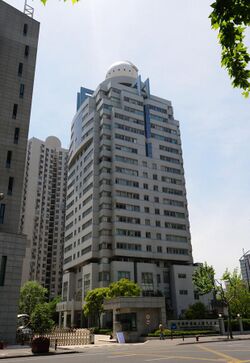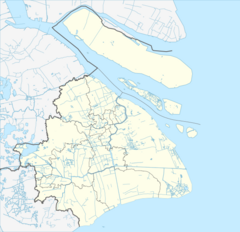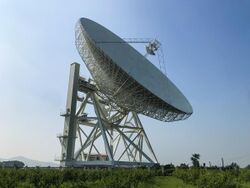Shanghai Astronomical Observatory
Topic: Astronomy
 From HandWiki - Reading time: 2 min
From HandWiki - Reading time: 2 min
 | |
| Organization | Chinese Academy of Sciences |
|---|---|
| Location | Xujiahui, Xuhui District, Shanghai |
| Coordinates | [ ⚑ ] : 31°11′25″N 121°25′46″E / 31.19028°N 121.42944°E |
| Website | www |
| Organization | Chinese Academy of Sciences | ||||||||
|---|---|---|---|---|---|---|---|---|---|
| Observatory code | 337 | ||||||||
| Location | Sheshan, Songjiang District, Shanghai | ||||||||
| Coordinates | [ ⚑ ] 31°05′57″N 121°11′58″E / 31.09917°N 121.19944°E | ||||||||
| Altitude | 100 m (330 ft) | ||||||||
| Weather | ~130 clear nights/year | ||||||||
| Telescopes | |||||||||
| |||||||||
Shanghai Astronomical Observatory (SHAO), is an astronomical observatory in Shanghai. It has a long history of astrometry and also operates the 25-meter (82 ft) Sheshan radio telescope as part of the Chinese VLBI array and the European VLBI Network (EVN).
History
It was formed in 1962 from the merger of the Xujiahui (also romanized as "Ziikawei") and Sheshan (Zose) observatories in Shanghai. It was involved with the Chang'e 1 Moon mission as the VLBI array is used for position determinations.
In October 2012 the Tian Ma 65-meter (213 ft) radio telescope was completed for SHAO.[1] It is part of the Chinese Academy of Sciences.
List of directors
- Li Heng (李珩) (1962 − Cultural Revolution)
- Ye Shuhua (1978−1979)
- Li Heng (1979–1981)
- Ye Shuhua (1981−1993)
- Zhao Junliang (赵君亮) (1993−2003)
- Liao Xinhao (廖新浩) (2003−2005, as executive vice director)
- Hong Xiaoyu (洪晓瑜) (2005−2017, as executive vice director until 2007)
- Shen Zhiqiang (沈志强; 2017–present)[2]
See also
- Sheshan Observatory
- List of astronomical observatories
Notes and references
- ↑ "Shanghai 65-Meter Radio Telescope Sees the First Light----Shanghai Astronomical Observatory,Chinese Academy of Sciences". http://english.shao.cas.cn/ns/es/201210/t20121029_94117.html.
- ↑ "Error: no
|title=specified when using {{Cite web}}". Shanghai Astronomical Observatory. http://www.shao.cas.cn/gkjj/lrld/. Retrieved 2018-12-10.
 |
Licensed under CC BY-SA 3.0 | Source: https://handwiki.org/wiki/Astronomy:Shanghai_Astronomical_Observatory1 | Status: cached on August 14 2024 06:18:06↧ Download this article as ZWI file
 KSF
KSF

